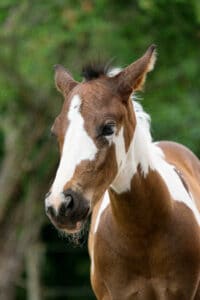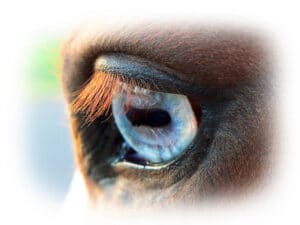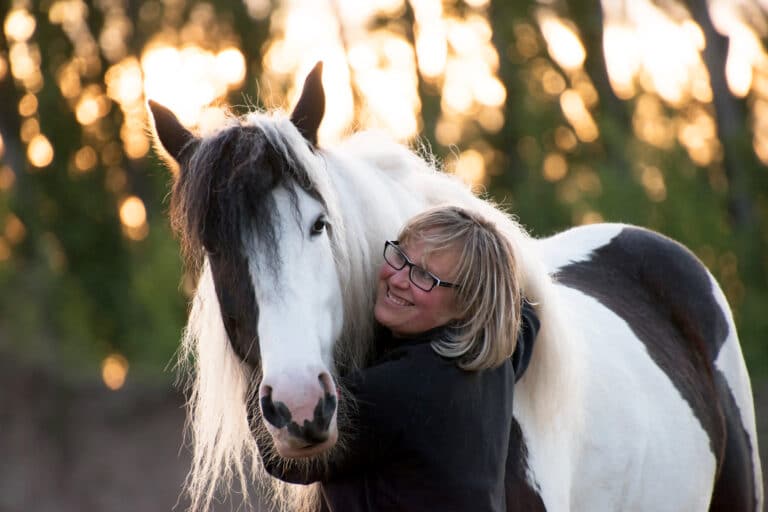Welcome to the world of champagne, pearl, and white as CHRISTINE ARMISHAW dives even deeper into fancy coat colours in the final of our two-part series.
Last issue I caught up with Kao Castle B.Sc.(Hons.)(Advanced) PhD, founder of Practical Horse Genetics, and learnt about base equine colours: what makes a horse turn grey, and the dilution effects of the cream, silver and dun genes. Now it’s time to delve deeper and find out about some of the even rarer dilute genes. Plus, we’ll discuss various white genes and how they impact a horse’s white markings or body patches, and which of those genes are linked to potential health issues.
Champagne tastes
Seen in the likes of Quarter Horses, Paints and sometimes Miniatures, the elusive champagne gene is really very beautiful and has properties that can be described as a cross between cream and silver genes in that it can affect both red and black genes. Kao describes it like this: “While a chestnut horse with a champagne gene will look much like a palomino, a black horse with a champagne gene presents as a stunning, lightened colour. It’s not quite the same as a silver, as the mane and tail don’t tend to lighten up as much.”
Another standout attribute often associated with the champagne gene is that instead of the normal dark brown, the horse’s eyes are an amazing green. “They’re kinda stunning!” says Kao. And if anyone knows a stunning colour, she does. Acting on bay, this dilute has a particularly eye-catching result: “When you get the champagne gene on a bay base, you’ll get a golden body, and the mane and tail will also lighten up to a really silvery colour,” she adds.

The beauty of pearl
The rarest of all the dilutes is the pearl gene. It’s so rare, you won’t see any of the coat-changing effects unless the horse has a pearl gene from both Mum and Dad. “A horse can carry one copy of the pearl gene and just look ‘normal’, but when it carries two copies of the pearl gene, it has a lighter coat colour and you get quite a beautiful, iridescent effect to the colour,” Kao explains.
Whiteout
From white socks and a blaze to full-on body patches, white can take shape in all manner of patterns on a horse, and multiple genes are responsible for all the different representations.
At a biological level, when we look at the areas of the body that are white, like socks, for example, what we’re seeing is a failure to produce colour over that area, thus the hair presents as white. “The colour hasn’t spread itself all the way around the developing horse foetus. The melanocytes, which are the cells that produce pigment, simply don’t make colour in those areas. So when your horse has a blaze, the colour just hasn’t made it to that part of the face,” Kao explains.

A touch of tobiano
The common gene that gives you those big, white body patches is called tobiano, and that will give you your classic pinto. “It can go on top of any other colour. So, you can have a chestnut tobiano, you can have a buckskin tobiano, you can have a dunalino tobiano, and you can have a dunalino tobiano that’s going grey!” Kao says, explaining how the genes are layered on top of one another and how many genes can be possible, all in the one horse.
Then there’s frame overo
The frame overo gene is responsible for the next most common white and colour patch arrangement. “The reason it’s called ‘frame’ overo is because it’s very rare for the white to cross over the spine,” Kao says. A horse that displays this gene will usually show white markings on the side of the neck, the rib cage and/or the belly, with a solid colour (not white) running down the spine. A fun feature sometimes seen in horses with this gene is the appearance of blue eyes.

When white gets wicked
Certain white genes are linked to serious health risks and the frame overo is indeed high-risk when both the mare and stallion carry this gene. According to Kao, the result is devastating: “Foals with overo lethal white syndrome are born either completely white or 95 per cent white, with blue eyes. Unfortunately, their intestines aren’t formed correctly, so they can’t move anything from the stomach through to the bowel. They can often stand up to drink, but then they end up with terrible colic. It’s heartbreaking, because it’s not something that can be fixed, so they have to be euthanised.”
And this is where the benefits of colour genetic testing get ramped up. Testing the parents to ascertain whether they both carry the frame overo gene can prevent a foal that may potentially suffer this sad fate from being conceived in the first place. “Paint people are fantastic about doing that, it’s super rare for paint horse breeders to not have an understanding about avoiding overo lethal white syndrome,” Kao says.
When to test
So when should you have your horse tested? Horses can carry either one or two copies of the tobiano gene without passing on any adverse health conditions. However, Kao’s advice is that because of the very serious possible health effects of the frame overo gene, you should test any horse that shows patches of white if you are planning to breed from them. “If you have a pinto horse that has white patches already from the tobiano gene, the frame overo gene could be hiding in there as well,” she explains. The good news is that if you’ve had your foundation breeding stock tested and they come back clear of the gene, it’s not something you need to continue testing for as it’s not going to just suddenly pop up.
Splash genes
Other white marking genes that harbour a potential health risk are the splash genes, which can cause deafness. “Splash doesn’t cause isolated patches the way tobiano and frame overo do. It’s got its own distinctive way of distributing white over the body,” Kao says. “It’s called ‘splash’ white because it looks like the horse waded into a dam of white paint and put its face in there.”
A classic example of a splash white coat pattern is a horse with high white stockings, a bald face and a tail that’s end has that dipped-in-white effect and, like the overo gene, the splash gene can also cause blue eyes. The problem with this gene is that when it causes white face markings to be so extensive that they reach the bottom of the ears, deafness can occur.
However, splash white doesn’t always cause big markings. “Sometimes it may present as just a couple of short socks. It’s a good one to test for if you happen to get one surprise blue eye,” Kao advises. “The most stunning example I’ve seen was in a black Miniature that had no white, but had two blue eyes. It was like a made-up horse. We tested it to figure out what was going on and it had a splash white gene, which was presumably making the eyes blue. But miniatures don’t really like to follow the colour rules,” she adds.

Classic sabino
While there are other white (W) genes that also produce an assortment of body markings, the sabino gene is the one behind those big expanses of white. “Think of typical Clydesdale markings with really high white socks, a lot of roaning and a big white blaze, that’s your traditional sabino look. Clydesdales don’t have the sabino gene, but that gives you an idea of the classic sabino stamp,” Kao explains.
Interestingly, all the white genes that are commonly tested for are actually quite closely related to one another. “Sabino, all the ‘W’ genes, and roan, are basically just different versions of each other, genetically speaking. They’re mutations of the same gene, which is why there are certain similarities to their looks,” she adds.
A noticeable one is W20, which is the gene generally responsible for your average horse sporting a couple of medium height white socks and a blaze. Less white than that, say a star or a small sock, won’t necessarily show up as a specific gene in a genetics test, rather it’s your horse’s own beautiful individuality coming through.
For more information, visit www.practicalhorsegenetics.com.au



